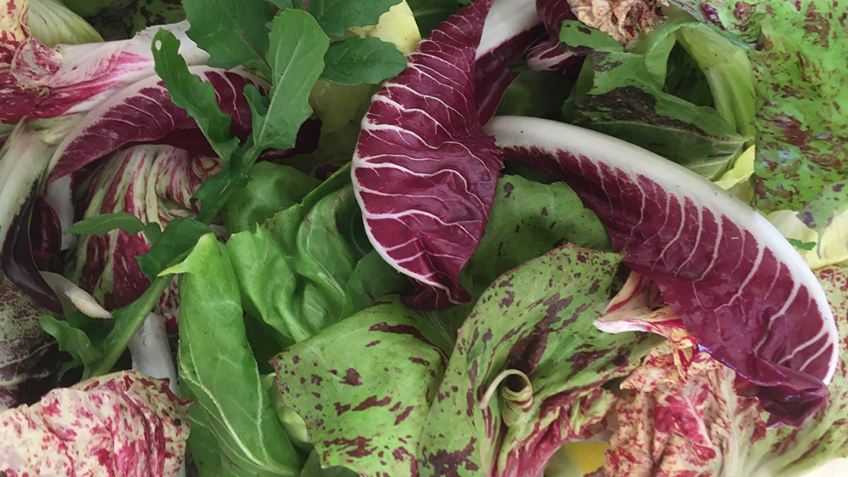Owl Farm Braidwood attend Carriageworks Farmers Market on the 2nd and 4th Saturday of each month. Best known for their garlic and award-winning potatoes, Owl Farm are also popular for their impressive range of bitter salad leaves such as radicchio.
We had a chat to Joint Owner and Grower David Dawes about his farm’s practice and his obsession for radicchio – including a handy guide to the different varietals he grows, all named after the towns in the Veneto region of northern Italy from where they originate.
Can you tell us about Owl Farm?
Owl Farm is located east of Braidwood nestled under the Budawang Ranges. We are a cold climate farm with 250 growing days a year, 40-degree summers and minus 10 winters. Our climate dictates what we can grow well and is very similar to the Veneto region near Venice.
We grow garlic, shallots, onions (Italian varieties), Japanese bunching onions (Negi), radicchio, endive, chicory, salad leaves, Brassicas, pumpkins, potatoes and rhubarb, and also smaller crops of beetroot, carrot, parsnip, spinach, tomatoes, capsicum and chillies.
Can you tell us about the farming practice?
We practice regenerative agriculture, and our goal is to improve our soil microbiology, rehydrate the landscape and to increase biodiversity. Really, we are soil farmers because if we manage our soil then we can grow anything, climate permitting – We are a cold climate farm with about 250 growing days a year.
We use no chemicals, minimum tillage (soil disturbance) and tread as lightly on the land as possible. We plant over 500 trees a year to minimise our carbon impact and are about to start a major creek regeneration project.
At the end of the day, we want to tell a better story and leave our land in a better condition than we found it.
Can you tell us about the different types of radicchio you grow?
- Treviso Tardivo (late) is the starting ancestor for all modern varieties. Must be harvested in autumn and the plants ‘forced’ in the dark to grow. The King of radicchio. Best eaten raw or cooked.
- Treviso Precoce (early). Bittersweet. Best eaten raw.
- Chioggia is typically Palla Rossa (red ball). Bitter. Best eaten raw or cooked.
- Di Verona. Deep crimson balls often forced. Bitter. Best eaten raw or cooked
- Di Lusia. Round head with light green and butter yellow leaves flecked with red. The most lettuce like radicchio. Best eaten raw or grilled.
- Castelfranco. The Queen of radicchio. Known as the ‘Winter Tulip’ because of the head’s shape. Leaves are green with red and yellow flecks. Bittersweet. Best eaten raw.
- Bianca di Chioggia. Bred in the 19990s. Loose round balls with supple green leaves. Best eaten raw or grilled.
- Pan di Zuccero or Sugarloaf radicchio from the Milan region. Sweet. Best eaten raw.
- Grumolo. Loose heads and small-leafed. Autumn and Spring harvest. Bittersweet
- Rosa di Gorizia. Dark red through neon pink. The ‘Rose of Winter’. Hard to grow, but worth the effort. Bittersweet. Best eaten raw.
- Escarole, Frisee, Endive are Cichorium endivia. More lettuce-like in looks and bittersweet. Best eaten raw.
- Puntarelle. A Catalonian chicory variety that produces asparagus like flower shoots.
We grow all twelve varieties and a total of 25 cultivars. We are least successful with Tardivo and Puntarelle at this stage, but all the others will be available in salad mixes or as individual heads. We also have bitter Italian chicory and dandelion on occasion – which is very popular!
When do you harvest radicchio?
Radicchio is mostly harvested in winter when the colours are at their brightest and the leaves can be at their sweetest. We start harvest in late March and try to keep a supply through to November.
What are you favourite ways to eat radicchio?
The bitterness is a wonderful flavour attribute. Radicchio can be eaten raw in a salad, often paired with citrus, or grilled or roasted. It is a good source of Vitamins A and C and iron. The bitter phytochemicals can aid with digestion.
Do you have any fave radicchio recipes?
- Grilled radicchio with melted Brillat Savarin or a soft goat’s cheese from Jennifer McLagan’s fabulous book Bitter.
- Grilled (over hot coals) radicchio risotto finished with Balsamic vinegar from the incomparable Alice Waters (Chez Panisse) Vegetables. You can also add pumpkin to this recipe.
- Yotam Ottolenghi’s bittersweet salad from Plenty – radicchio and other bitter leaves dressed in an orange syrup.
What is your favourite thing about trading at Carriageworks Farmers Market?
It’s a real community between the Markets team and stallholders, who are supportive and welcoming, and with the public. We have regulars who affirm what we are trying to achieve and each week we are delighted by the feedback and encouragement. We feel like we are providing food at an affordable price to a wide number of households and that is the best reward we can have as a grower.
Make sure to visit Owl Farm next time you’re at the Carriageworks Farmers Market. Open from 8am – 1pm, every Saturday.




